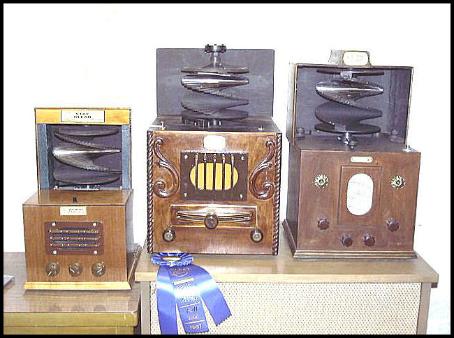1928 was actually the beginning of the first television boom period. More then a dozen radio stations were either planning to, or were already periodically transmitting television signals, generally late at night at frequencies slightly higher than the broadcast band.
Many of the radio listeners at this time heard their first radio stations on one or more crystal radios, that they had
successfully built based on information and drawings shown in their daily newspapers. In the process, they also
would have erected good antennas as well as a good ground. Also by 1928, they were likely to have purchased a sensitive radio set, certainly more sensitive than their crystal set. |

|
By this time, radio had really captured the imagination of the public. Many owners were attempting to log as many stations as the could. First by radio, followed by letter or postcard. Because of the nature of signal frequencies in the broadcast band, the strength of the received signals are much greater at night and even more so at the high end of the band. As a result, those looking for new stations to receive spent most of their radio time after dark, at the high end of the broadcast band.
Some radio stations, seeing potential new business with television, began to look for ways to get involved without creating interference with the existing services. They could do this with a simple temporary change in the transmitter. With the change in place, instead of a microphone input to the transmitter, now it would be from a photocell associated with some sort of image scanner.
As for the listeners tuning in new stations at the top of the band, instead of voices or music, they instead heard loud unsteady buzzing, squealing or what seemed to be an unusual form of noise. At the same time, the newspapers once again began running regular construction articles, telling the readers what the stations were doing and how one might build something that actually shows pictures. It seemed like magic.
There were some new words to be learned too, such as Nipkow scanning disk, synchronizing and flicker. There were a number of magazines dedicated to radio, that were beginning to run regular articles about television matters, including how to build all or part of a receiver. The same magazines were running ads, for various television parts or complete kits, that anyone could put together (or so they said). Just about all of the televisions offered used a Nipkow disk, that generally guarantees that one will have a small dim picture. Typical image size on a Nipkow disk is one to two inches square. Light efficiency is is many times less than 1% and the approximate ratio between the scanning disk size and the image size works out to be about the same ratio.
In the same year (1928), D. B. Gardner filed a USA patent No.1753697 for a mirror screw scanning apparatus. His scanner offered a viewable image almost as large as the scanner. Also the light efficiency was very high because it is was a helical scanner made up of mirrors. It became known as the mirror screw.
Most of the television pioneers of that time were radio engineers that were also responsible for sending out television signals that could be picked up with an ordinary radio. Names like Sanabria, Jenkins and Baird (of Boston Mass) where among the many who became well known because of frequent stories and articles appearing in magazines and newspapers. Many times, the authors were actually the inventors, describing their inventions.
Sanabria was showing off his interlaced scanning. Jenkins had a wide range of developments including some very clever scanning techniques and Baird had a drum scanner with a quick and easy change to other line formats.They were all using Nipkow disks in one form or other, which was invented in 1884. Nipkow's patents had long ago run out, so there were no royalties to be concerned with...and no lawyers. In general, it seems that in the field of television development, that the inventors for the most part, felt that they could and would invent whatever they needed as they went along. There was always a very strong reluctance to paying
royalties to anyone, for anything. They just wanted to collect them. In later years, RCA was especially noted for this. This might explain why there was no mirror screw activity in the USA at any time, although it is known that in the early 1930's, RCA did have in their development inventory, two 60-line mirror screws.
It appears from here, that the best scanner in 1928 and some years later as well, was the mirror screw! However, no one in the USA picked it up, and only in Europe was there any interest. Franz von Okolicsanyi of Hungary began putting the mirror screw to use and in some ways made significant improvments in its operation. In later years, he claimed that he invented the mirror screw, but neglected to patent it in a timely manner. He was later employed by Tekade of Germany as a high level engineer, with the task of developing a low cost mechanical television for the home.
Peter Yanczer... 5/25/09 |